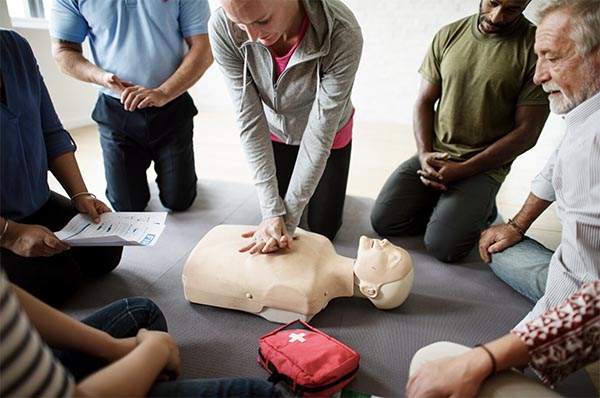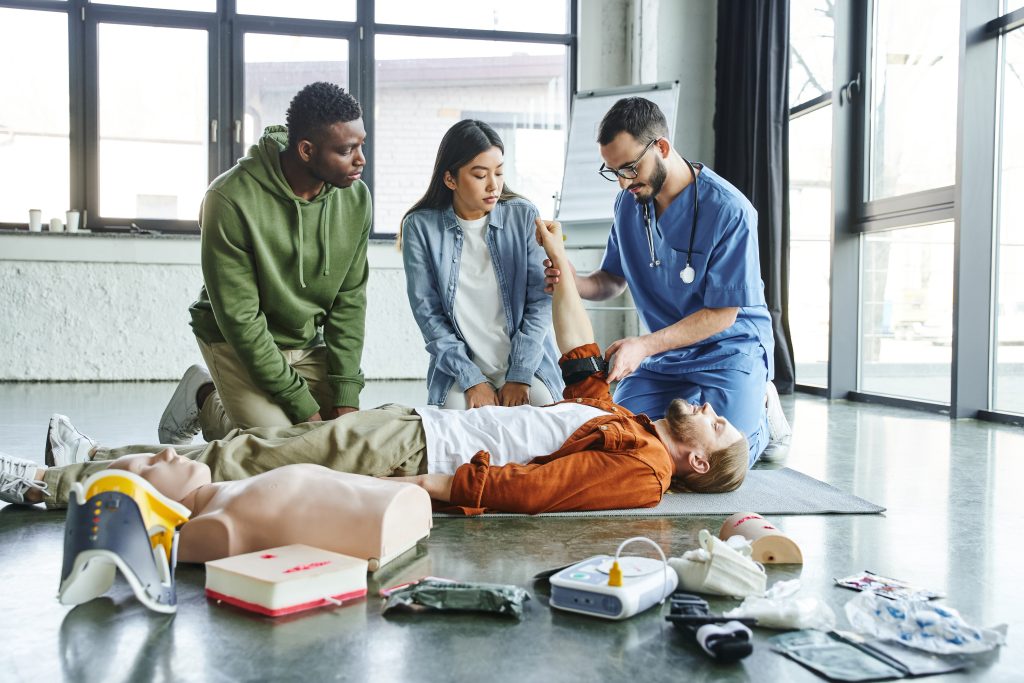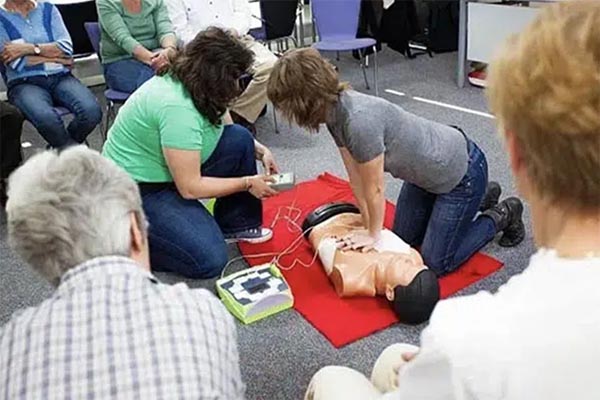
In the bustling classrooms and playful daycare centers of Austin, Texas, teachers and care providers are the front-line heroes of childhood. Every day, you guide, inspire, and protect the next generation. While lessons on mathematics and art are essential, the most important knowledge you can possess may be the kind that saves a life. Being a first responder for a child in distress isn’t just a job requirement; it’s a profound responsibility.
This guide is designed to empower you with the knowledge and confidence to handle common emergencies. It goes beyond the basics to cover the specific first aid skills every teacher and daycare provider in Austin should know. Our goal is to ensure you are fully prepared to act swiftly and effectively when it matters most, creating a safer environment for every child under your care.
Why First Aid Is Non-Negotiable for Austin’s Educators
Accidents don’t send out a calendar invite. They can happen in the blink of an eye, from a scraped knee on the playground to a more serious allergic reaction. For a child, a few seconds can make all the difference. As the primary adults on the scene, your ability to provide immediate and appropriate care is critical. Your quick actions can prevent a minor incident from escalating or, in some cases, bridge the vital gap until professional medical help arrives.
The environment of a school or daycare presents unique challenges. Children are naturally curious and energetic, which can lead to falls, cuts, and minor injuries. They are also more susceptible to certain illnesses and reactions. Knowing how to differentiate between a simple bump and a more serious head injury, or recognizing the signs of an anaphylactic shock, is the foundation of a safe learning environment.

The Cornerstone Skill: Pediatric CPR and Choking Response
Without a doubt, the most crucial life-saving skill for anyone working with children is CPR, or Cardiopulmonary Resuscitation. Pediatric CPR is different from adult CPR, requiring specific techniques tailored to the size and physiology of a child or infant. Learning to perform chest compressions and rescue breaths on a small body is a skill that could be the difference between life and death.
Choking is another major concern in any setting with young children. From a small toy part to a piece of food, a blocked airway is a life-threatening emergency. Knowing how to perform back blows and abdominal thrusts (Heimlich maneuver) on a child or infant is an essential skill that must be practiced and mastered. Timely intervention can clear the obstruction and allow the child to breathe again, often before paramedics can even arrive on the scene.
Recognizing and Managing Allergic Reactions
Food allergies and insect sting allergies are increasingly common. An allergic reaction, especially anaphylaxis, can be a rapid and severe medical emergency. For educators, the ability to recognize the early signs—such as hives, swelling, difficulty breathing, or a sudden drop in blood pressure—is paramount.
Knowing when and how to administer an epinephrine auto-injector (like an EpiPen) is a life-saving skill. You must be trained to use this device correctly and confidently. A delay in giving epinephrine can have severe consequences. Being prepared to act on a child’s emergency plan and calmly follow the steps is a true measure of preparedness.
First Aid for Common Playground Injuries
Playgrounds are a hub of fun, but also a common source of injuries. A fall can result in a sprained ankle, a broken bone, or a head injury. Teachers and daycare providers should be proficient in basic wound care and the initial management of fractures.
For cuts and scrapes, knowing how to clean the wound, apply pressure to stop bleeding, and bandage it properly prevents infection. For a suspected fracture, the key is to immobilize the injured limb and seek professional medical attention. Never try to reset a bone. Recognizing the signs of a concussion, such as disorientation, vomiting, or loss of consciousness—is also vital, as these injuries require immediate medical evaluation.
Handling Fevers and Illnesses
Children often come to school or daycare with minor colds, but a sudden fever can be a sign of a more serious illness. Educators should be trained to take a child’s temperature and know the protocol for isolating a sick child to prevent the spread of germs. It’s also important to understand when a fever warrants an immediate call to parents or emergency services.
Beyond fever, other common symptoms like vomiting or severe stomach aches need to be taken seriously. Your role is not to diagnose, but to observe, provide comfort, and initiate the communication chain to ensure the child receives the necessary care from their parents or a healthcare professional.
Emergency Preparedness and Communication
First aid skills are only one part of a comprehensive safety plan. Every school and daycare in Austin should have clear, well-rehearsed emergency protocols. This includes knowing the location of the first aid kit, having up-to-date contact information for every child’s parents, and knowing who to call in a medical emergency.
Practicing emergency drills, including scenarios for choking or allergic reactions, can help reduce panic and ensure that everyone knows their role. Clear, calm communication with other staff members and emergency responders is also key. Your ability to provide an accurate and concise description of the situation will help first responders prepare and act more effectively upon arrival.

The Importance of Certification and Ongoing Training
First aid is not a “set it and forget it” skill. Like any life-saving procedure, it requires regular practice and recertification. Guidelines for CPR and first aid can change as new research emerges. Staying current with your training ensures you are using the most effective and up-to-date techniques.
For teachers and daycare providers in Austin, TX, a formal certification course provides the hands-on practice and expert instruction needed to feel truly prepared. These courses cover everything from basic CPR and first aid to more advanced pediatric-specific emergencies. They provide a safe environment to practice and ask questions, building the confidence you need to act decisively in a real-life situation.
Conclusion
The safety of children is a shared responsibility, and as an educator, you are a vital link in that chain. Possessing strong first aid skills and a valid CPR certification is more than a professional requirement; it is a commitment to the well-being of the children who look to you for guidance and protection. By investing in your training, you are not just preparing for an emergency, you are creating a secure and nurturing environment where every child can thrive.
Be the hero in the classroom. Don’t wait for an accident to happen. Take the proactive step to get certified. To learn more about getting your CPR and first aid certification, or to schedule a class, please contact CPR Classes Near Me in Austin, TX. Your preparedness today can save a life tomorrow.
FAQs About First Aid for Austin’s Educators
1. Why is pediatric CPR different from adult CPR?
Pediatric CPR is different because children’s bodies are smaller and their physiological needs vary. Most cardiac arrests in children are a result of a breathing problem (e.g., choking or respiratory illness), while in adults, they are typically caused by a cardiac event. This difference means the CPR protocol for children places a greater emphasis on rescue breaths in addition to chest compressions. The depth of compressions and the rate also vary to prevent injury to the child’s smaller frame.
2. How often do I need to renew my CPR and First Aid certification?
Most professional CPR and First Aid certifications, especially those recognized by organizations like the American Heart Association (AHA) and the American Red Cross, require renewal every two years. This two-year cycle ensures that your skills remain sharp and that you are up-to-date on any new guidelines or techniques. Some employers may require more frequent training or refreshers, so always check with your school or daycare’s specific policies.
3. What should I do if a child is choking but can still cough?
If a child is choking but can still cough, it means their airway is only partially blocked. In this situation, you should encourage the child to continue coughing. Do not perform back blows or abdominal thrusts (the Heimlich maneuver) if they are still able to breathe and cough. These maneuvers could potentially dislodge the object and cause it to become completely stuck, fully blocking the airway. Stay with the child, keep them calm, and be prepared to act if their condition worsens and they become unable to cough or breathe.
4. What are the signs of a severe allergic reaction (anaphylaxis)?
Anaphylaxis is a severe, life-threatening allergic reaction. The signs can appear quickly and include hives, swelling of the face, tongue, or throat, difficulty breathing, wheezing, a rapid or weak pulse, a sudden drop in blood pressure, and dizziness or fainting. A child may also complain of a feeling of “doom” or a feeling that something is wrong. Anaphylaxis requires immediate medical attention and the administration of an epinephrine auto-injector as soon as possible.
5. How do I choose the right first aid and CPR class for teachers and daycare providers?
Look for a class that is specifically designed for pediatric first aid and CPR. The class should be taught by certified instructors and should cover skills like infant and child CPR, choking relief, and managing common childhood emergencies like allergic reactions, fevers, and injuries. A good class will offer hands-on practice with manikins and provide scenarios relevant to a school or daycare environment. Be sure the certification you receive is nationally recognized and accepted by your employer or state regulations in Austin, TX.

Leave a Reply